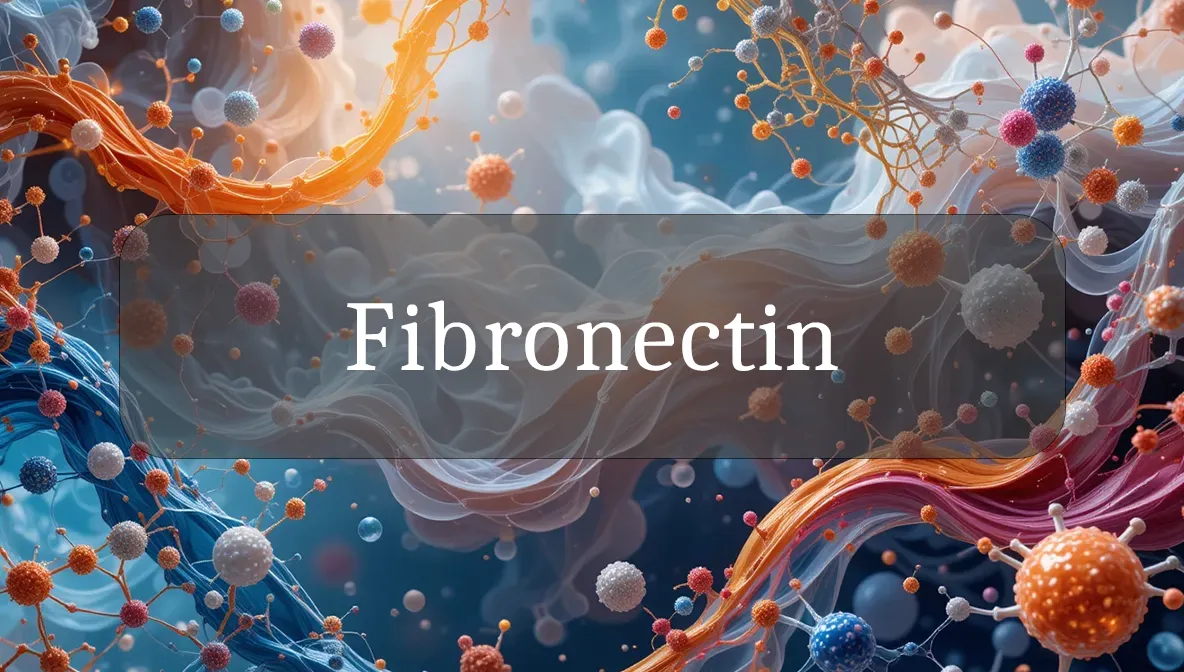Connective Glue for Tissue Repair and Resilience
Fibronectin is like your body’s natural adhesive, a protein that binds cells and tissues together, supporting repair, growth, and strength. Found in your connective tissues and blood, it’s a key player for health-conscious folks aiming to maintain tissue integrity and vitality. Understanding fibronectin can empower you to make choices that enhance healing and overall wellness. Let’s explore what fibronectin is, why it matters, and how you can nurture its function for daily vitality!
Chemical Identity and Type
Fibronectin is a large glycoprotein, a body signal made of approximately 2,500 amino acids, produced by fibroblasts, endothelial cells, and other cell types. It exists in two forms: insoluble (in the extracellular matrix of tissues) and soluble (in blood plasma). Fibronectin binds to cells, collagen, and other matrix components, forming a scaffold for tissue structure and repair. Think of it as the glue that holds your body’s framework together, enabling healing and resilience.
Biological Role and Benefits
Fibronectin is a cornerstone of your connective tissue and healing processes, offering these benefits:
- Wound Healing: It guides cell migration and tissue repair, forming a temporary scaffold for new tissue growth after injuries.
- Tissue Strength: Fibronectin supports the extracellular matrix in skin, tendons, and organs, enhancing structural integrity.
- Cell Adhesion: It helps cells stick to each other and the matrix, ensuring stable tissue architecture and function.
- Embryonic Development: Fibronectin is critical for tissue formation in embryos, supporting growth and organ development.
- Immune Support: It aids immune cell movement, helping fight infections and inflammation at injury sites.
Healthy fibronectin levels promote rapid healing, strong tissues, and overall vitality.
Dietary or Natural Sources
Your body produces fibronectin naturally, relying on amino acids and nutrients for synthesis. You don’t get fibronectin directly from food, but you can support its production with these nutrient-rich choices:
- Protein-Rich Foods: Chicken, fish, eggs, and beans provide amino acids like glycine and arginine for fibronectin synthesis.
- Vitamin C-Rich Foods: Oranges, strawberries, and bell peppers support collagen and fibronectin production, aiding tissue repair.
- Zinc-Rich Foods: Oysters, pumpkin seeds, and beef promote wound healing and fibronectin function.
- Antioxidant-Rich Foods: Berries, leafy greens, and nuts protect fibronectin from oxidative damage caused by inflammation or aging.
A balanced diet with these nutrients supports fibronectin production and tissue health.
Signs of Imbalance or Dysfunction
Reduced fibronectin production or dysfunction (due to aging, chronic inflammation, or disease) may show up as:
- Slow Wound Healing: Delayed recovery from cuts, bruises, or surgical wounds.
- Tissue Weakness: Fragile skin, weak tendons, or poor connective tissue strength.
- Chronic Inflammation: Persistent swelling or pain, as fibronectin dysregulation can impair tissue repair.
- Scarring Issues: Excessive or abnormal scarring from improper fibronectin scaffolding.
- Fatigue or Joint Pain: Weakened connective tissues affecting mobility or energy.
These symptoms can have many causes, so if they persist, consult a healthcare provider to explore connective tissue or healing-related issues.
Supporting Optimal Levels or Function
To enhance fibronectin production and function, try these evidence-based tips:
- Eat Nutrient-Dense Foods: Include fish, citrus fruits, or nuts to provide amino acids and antioxidants for fibronectin synthesis.
- Exercise Moderately: Activities like walking, yoga, or strength training promote blood flow and tissue repair, supporting fibronectin activity.
- Protect Skin and Tissues: Use sunscreen (SPF 30+) and avoid smoking to prevent damage to fibronectin-containing matrices.
- Stay Hydrated: Drink water to maintain tissue moisture, aiding fibronectin’s role in cell adhesion and repair.
- Manage Stress: Meditation or deep breathing reduces chronic inflammation, which can impair fibronectin function.
Small, consistent habits create a fibronectin-friendly environment for healing and tissue strength.
Safety, Interactions, and Precautions
Fibronectin is a natural protein and safe when balanced, but consider these factors:
- Chronic Conditions: Diseases like diabetes or fibrosis can disrupt fibronectin regulation, slowing healing or causing excessive scarring. Seek medical management.
- Supplements: No direct fibronectin supplements exist, but collagen, vitamin C, or zinc supplements may support connective tissues. Consult a healthcare provider before use.
- Medications: Some drugs (e.g., corticosteroids) may affect fibronectin production or tissue repair. Discuss with your doctor.
- Genetic Disorders: Rare conditions like fibronectin glomerulopathy involve fibronectin dysfunction and require specialized care.
Protecting fibronectin balance means supporting tissue repair and minimizing chronic inflammation.
Fun Fact
Did you know fibronectin acts like a cellular GPS during wound healing? It guides repair cells to the injury site, ensuring your body patches up cuts and scrapes with precision!
Citations
- National Institutes of Health (NIH): Fibronectin and Wound Healing.
- Mayo Clinic: Connective Tissue Health and Repair.
- Cleveland Clinic: Nutrition and Tissue Wellness.
- World Health Organization (WHO): Diet and Musculoskeletal Health Guidelines.
- USDA: Dietary Guidelines for Americans – Nutrient-Dense Diets.

